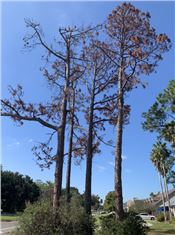Damaging Pest On The Rise In Louisiana Pines
Johnny Morgan
BATON ROUGE, LOUISIANA
Stress for trees can be a lot like stress in humans — too much is never a good thing.
Pines, the main tree species in Louisiana forests, are susceptible to several biotic and abiotic stresses, said Raj Singh, LSU AgCenter plant doctor.
Singh said the infestation Is widespread, and he has received calls from Lafayette, New Orleans, Gonzales and Destrehan.
“Pine trees stressed by Armillaria or Phytophthora root rot, drought stress, lightning strike, windstorm damage or other physical or mechanical injuries attract small bark beetles and borers,” he said.
One of these beetles is called the Ips beetle (Insecta: Coleoptera: Curculionidae: Scolytinae). These beetles, also known as wood engravers, are small, measuring just 3 to 5 millimeters long. They vary from reddish-brown to black in color.
“Adult male beetles attack stressed trees, tunnel into phloem tissue and build a nuptial chamber,” Singh said. “Female beetles are attracted to aggregation pheromones released by males, and after mating, egg galleries are created that radiate from the nuptial chamber, and eggs are laid in these galleries.”
Larvae will tunnel and feed on the phloem tissue underneath the tree bark. As a result, the affected parts of the tree will turn brown. Sometimes, the entire tree will turn brown and die.
Sawdust is present between the bark crevices and accumulates around the base of the tree trunk.
“Adult beetles feed on the phloem tissue and exit the affected trees through small round holes,” he said. “The presence of these numerous small holes on the tree trunk indicate that the beetles have completed their life cycle.”
There are five common species of bark beetles in the southern United States belonging to genus Ips and Dendroctonus.
Accurate identification is critical for management purposes. The Ips adult produces H-, I- or Y-shaped galleries, whereas the southern pine beetle (Dendroctonus frontalis) produces S-shaped galleries.
The southern pine beetle is considered a major economical pine timber pest in the southern United States, he said.
Management of Ips beetles in urban and residential pine trees requires strategies including mitigating biotic and abiotic stresses and improving tree health by providing proper fertilization and adequate moisture.
“Water pine trees during extended periods of drought,” he said. “Do not stack freshly cut pine logs near healthy living pine trees.”
Provide adequate spacing when planting new trees, and remove pine trees that are declining or stressed from drought or windstorms, he said.
“Pine trees infested with Ips beetles should be removed,” Singh said. “Once a tree is infested, chemical treatment is ineffective.”
Insecticidal treatments are not cost-effective and often require certified chemical applicators with proper equipment to treat high-valued pine trees.
For more information on pine trees infested with Ips beetle, contact the LSU AgCenter Plant Diagnostic Center at www.lsuagcenter.com/plantdiagnostics. ∆

A stand of dead pine trees infested with Ips beetles. The trees were damaged from storm-force winds produced by hurricane Ida in the fall of 2021.
Photo by Raj Singh/LSU AgCenter